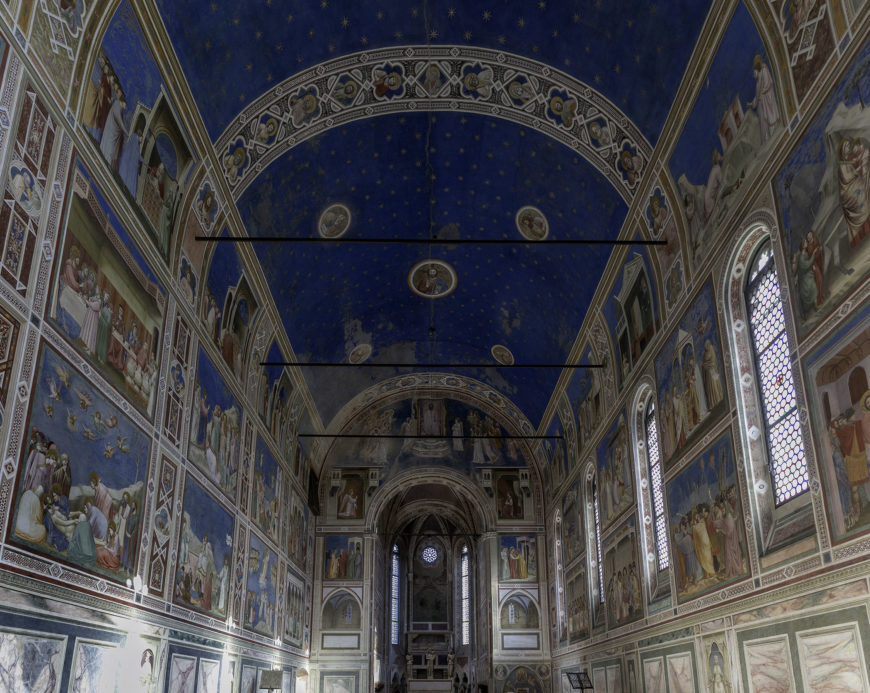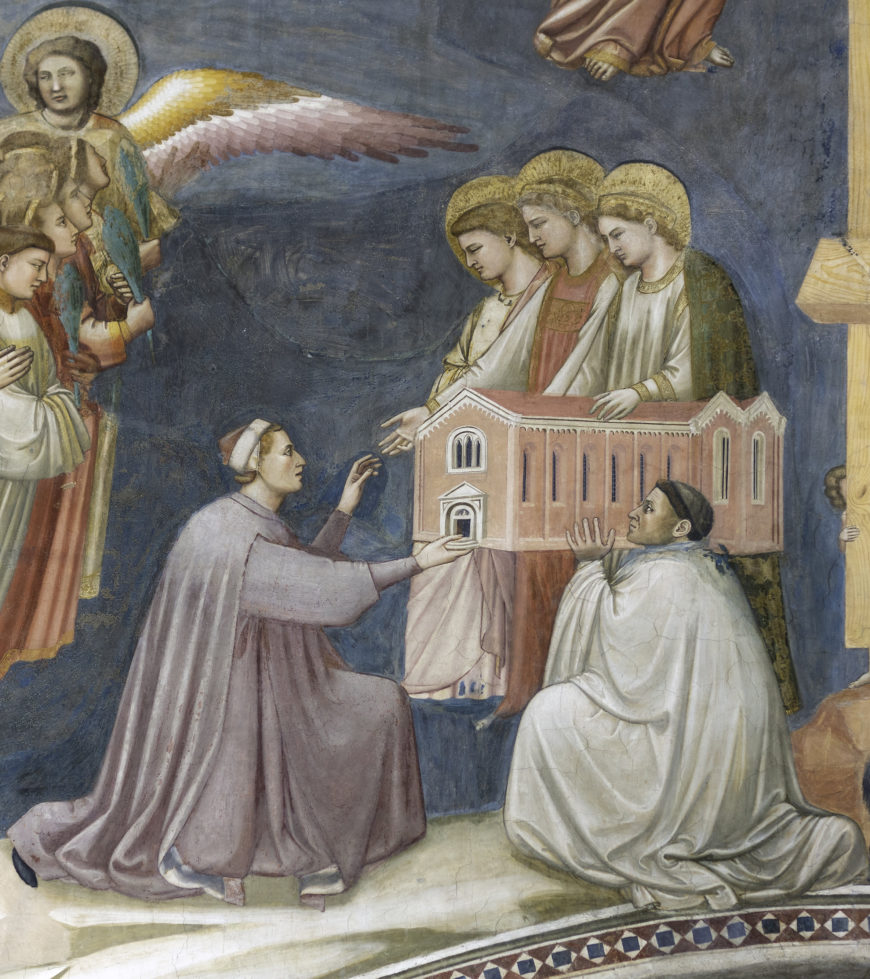Painting covers every inch of this chapel, from the spiraling narrative cycle to the star-studded blue sky.
Giotto, Arena (Scrovegni) Chapel, Padua, c. 1305

Fresco cycle by Giotto, Arena (Scrovegni) Chapel, Padua, c. 1305 (photo: Steven Zucker, CC BY-NC-SA 2.0)
Late medieval or proto-renaissance?
The Renaissance does not have a start date. Its origins are often located around 1400 but as early as the late 1200s we see changes in painting and sculpture that lay the foundation for what we will come to recognize as the Renaissance. Some scholars call this early period the “Late Gothic“—a term which refers to the late Middle Ages, while other people call it the “Proto-Renaissance”—the beginnings of the Renaissance. In any case, a revolution is beginning to take place in Italy the early 1300s in the way people think about the world, the way they think about the past, and the way they think about themselves and their relationship with God.
Giotto
The artist who takes the biggest step away from the medieval style of spiritual representation in painting in the early 14th century is Giotto.
Giotto is perhaps best known for the frescoes he painted in the Arena (or Scrovegni) Chapel. They were commissioned by a wealthy man named Enrico Scrovegni, the son of a well-known banker (and a banker himself). According to the Church, usury (charging interest for a loan) was a sin, and so perhaps one of Enrico’s motivations for building the chapel and having it decorated by Giotto was to atone for the sin of usury. The chapel is known as the Arena Chapel since it is on the site of an ancient Roman arena (or amphitheater) that later became the property of Scrovegni, whose palace abutted the chapel (the palace was torn down in the nineteenth century, though parts of the arena remain).

Enrico Scrovegni assisted by a priest, presents the chapel to the Virgin Mary and two other figures (detail), Giotto, Last Judgment, c. 1305, fresco cycle (Arena (Scrovegni) Chapel, Padua, Italy; photo: Steven Zucker, CC BY-NC-SA 2.0)
Commissioning works of art for churches was a common way of doing “good works” which could help you earn your way into Heaven. We can see Enrico himself in the fresco of the Last Judgment on the west wall of the Arena Chapel—he is shown on the side of the blessed (or the elect, those whom Christ has chosen to go to Heaven). He is depicted kneeling, presenting the chapel to the Virgin Mary and two other figures (variously identified). [1]
The photo at the top of the page gives us a sense of what it feels like to be a tourist visiting the Arena Chapel. Because frescoes are painted directly on the wall, they can’t easily be moved and put in a museum. Most frescoes are therefore still in the spaces that the artists created them in and that the patrons commissioned them for. Having the work of art in its original context helps us to understand its meaning for the people of the 14th century.
Looking at the photo, you can see that there are numerous separate images in the chapel. The frescoes tell the story of the lives of Mary (beginning with her parents, Joachim and Anna) and Christ on the long walls. By the altar, Giotto painted the Annunciation, and at the other end, on the entrance wall, the Last Judgment.
Rather like a comic book without words, Giotto tells the story of Christ and his parents through pictures. Most of the population of Europe was illiterate at this time and so couldn’t read the Bible for themselves (Bibles were rare and expensive in any case—there was no printing press and so each was copied by hand). People learned the stories of the Bible—stories that would help them get to heaven—by hearing the words of the priest in the church, and by looking at paintings and sculptures.
Notes:
[1] In one interpretation, the nearest figure is the Annunciate Virgin, the middle figure is Saint Mary of Charity (so the two important roles Mary plays in the chapel), and the last figure is the Angel Gabriel. Another source identifies these additional figures as St. John the Evangelist and Mary Magdalene. These figures have also been identified as the Virgin Mary, the Virgin of Charity and the Virgin Annunciate.
Additional resources:
Smarthistory video on the Arena Chapel (Part 1 of 4)
Smarthistory video on the Arena Chapel (Part 2 of 4)
Smarthistory video on the Arena Chapel (Part 3 of 4)
Smarthistory video on the Arena Chapel (Part 4 of 4)
Official site of the Arena Chapel
Dr. Allen Farber’s page on the Arena Chapel
Smarthistory images for teaching and learning:
[flickr_tags user_id=”82032880@N00″ tags=”scrovegni,”]
[0:00] [music]
Dr. Steven Zucker: [0:04] We’re in the Arena Chapel, a small private chapel that was connected to a palace that was owned by the Scrovegni family.
Dr. Beth Harris: [0:13] It was the Scrovegni family who commissioned Giotto to decorate this chapel with frescoes.
Dr. Zucker: [0:19] It’s called the Arena Chapel because it’s next to an ancient Roman arena.
Dr. Harris: [0:23] When you’re inside it, as we are now, I have to say that it’s taller than I expected, and that feeling of being enclosed by images that happens when you’re in a space entirely covered with fresco.
Dr. Zucker: [0:36] There are lots of narrative scenes, but even in between those scenes are trompe l’oeil faux marble panels. We get the sense that there is inlaid stone, but in fact, this is all painting.
Dr. Harris: [0:49] That extends even onto the ceiling, where we have a star-studded blue sky with images of Christ and Mary and other saints and figures.
Dr. Zucker: [0:59] The Arena Chapel is organized in a very strict way. Three registers begin at the top and move downward. I think of it as a spiral. That is, it tells a continuous story.
[1:09] It begins with Christ’s grandparents. It goes into the birth of Mary, her marriage, and then when we get down to the second register, we get to Christ’s life, or ministry. Then the bottom register is the Passion. These are the events at the end of Christ’s life and immediately after his death.
Dr. Harris: [1:27] Now, all of this is thanks to — strangely, it might seem to us today — a sin, the sin of usury that weighed heavily on the conscience of Enrico Scrovegni, whose palace was next door and who owned this land and built this chapel and hired Giotto. His father was a usurer. Enrico himself was a usurer.
Dr. Zucker: [1:48] What this means is he charged interest. Just like when you borrow money from a bank, you’re charged interest. When you put money on a credit card, you’re charged interest.
[1:57] In a very Catholic environment, being a banker made you a lot of money but it also, in your belief system, would send you to hell. Dante, the great late medieval poet, in his most famous poem, “The Divine Comedy,” singles out Scrovegni’s father for one of the more treacherous parts of hell.
Dr. Harris: [2:15] Enrico was really worried, and for this reason he did, in Catholic belief system, a good work. He built this chapel. This was his way of atoning for the sin of usury, hoping that this would help his soul to go to heaven.
[2:33] We see Enrico himself here in this chapel on the wall over the entrance; where Giotto painted the Last Judgment, we see Enrico kneeling, handing the chapel over.
Dr. Zucker: [2:45] To the three Marys. The Virgin Mary in the middle.
Dr. Harris: [2:48] Notice where Enrico has put himself. He’s on the side of the blessed in the Last Judgement; we see Christ at the very top and the damned are on Christ’s left and the blessed are on Christ’s right, and that’s where we find Enrico.
Dr. Zucker: [3:01] An impetus for this entire cycle can be seen at the apex of the triumphal arch of the opposite wall with God, who calls Gabriel to his side, telling him to go to the Virgin Mary and announce to her that she will bear humanity’s savior, that she will bear Christ.
Dr. Harris: [3:18] Interestingly, when Giotto painted God, he inserted a panel painting, so that is not fresco. Interestingly he chose to paint it in a style that was more conservative, less earthly than the style that we see in the frescoes.
[3:34] But just to go back to that wall, we begin to see the illusionism that we see throughout the cycles. If we look to Mary and the angel, Giotto has created an architectural space for each of them. These are not panel paintings with gold backgrounds that suggest a divine space. These are earthly settings for Mary and the angel.
Dr. Zucker: [3:56] Two scenes below the Annunciation are these wonderful empty, architectural spaces, these rooms, that have oil lanterns that hang from their ceilings, and there is such a delicate sense of space, of light and shadow. It is this bravura example of naturalism. It shows Giotto’s interest in the world, the present, the physical space that humanity occupies.
[4:19] [music]

